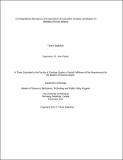Cis-Regulatory divergence and expression of ryanodine receptor paralogues in Medaka (Oryzias latipes)

View Open
Metadata
Show full item recordAuthor
Baakdhah, Tahani
Date
2013-06-12Citation
Baakdhah, Tahani. Cis-Regulatory divergence and expression of ryanodine receptor paralogues in Medaka (Oryzias latipes); A Thesis Submitted to the Faculty of Graduate Studies in Partial Fulfilment of the Requirements for the Masters of Science Degree. Winnipeg, Manitoba, Canada: University of Winnipeg, 2011.
Abstract
Ryanodine receptors (RyRs) are large homotetrameric proteins that in mammals are encoded by three genes: RyR1 in skeletal muscle; RyR2 in cardiac and smooth muscle; and RyR3 which is expressed in a diversity of cell types. RyR channels play a central role in the excitation-contraction (EC) coupling process by mediating Ca²+ release from the sarcoplasmic reticulum (SR). RyR1 paralogues are expressed in a fiber type-specific manner in fish skeletal muscles: RyR1a in slow-twitch skeletal muscle (red muscle) and RyR1b in fast-twitch skeletal muscle (white muscle). RyR1a and RyR1b are classic examples of spatial subfunctionalization, since they share an ancestral function, yet are expressed differentially in red and white muscle fibres respectively. Gene duplication and subsequent divergence in sequence, expression and interactions are considered to be one of the major driving forces in the evolution of diversity. After the upstream promoter regions, evolutionarily conserved introns are considered the second most important sites containing gene regulatory elements that control tissue-specific expression (gene enhancers or gene silencers). Using medaka (Oryzias latipes) as a model organism, I searched the noncoding sequences in medaka RyR1 and RyR3 genes to look for conserved noncoding elements for RyR co-orthologues and paralogues. The bioinformatic analyses revealed evidence of conservation of noncoding elements for RyR co-orthologues and divergence between RyR paralogues. I also analyzed the spatial and developmental expression of the RyR paralogues (RyR1a/RyR1b; RyR3a/RyR3b) in medaka. The expression analyses revealed conserved expression patterns for the RyR co-orthologues and divergent expression of the RyR paralogues.
